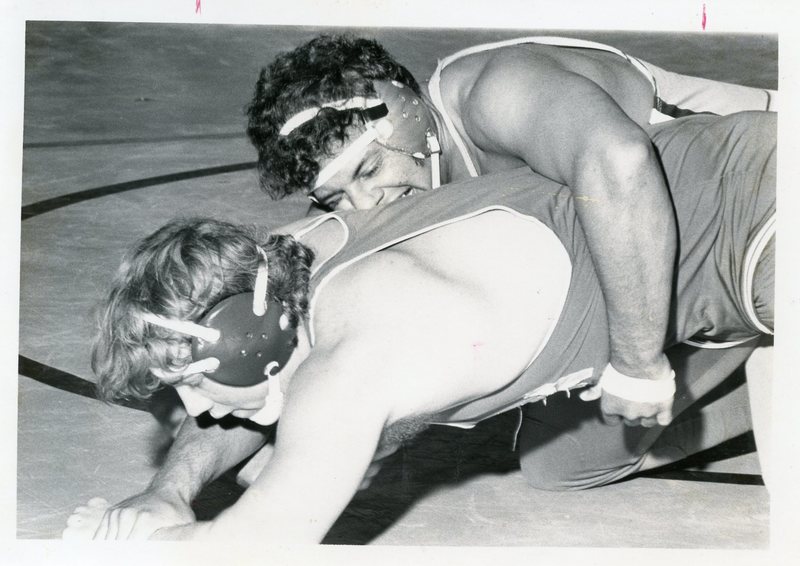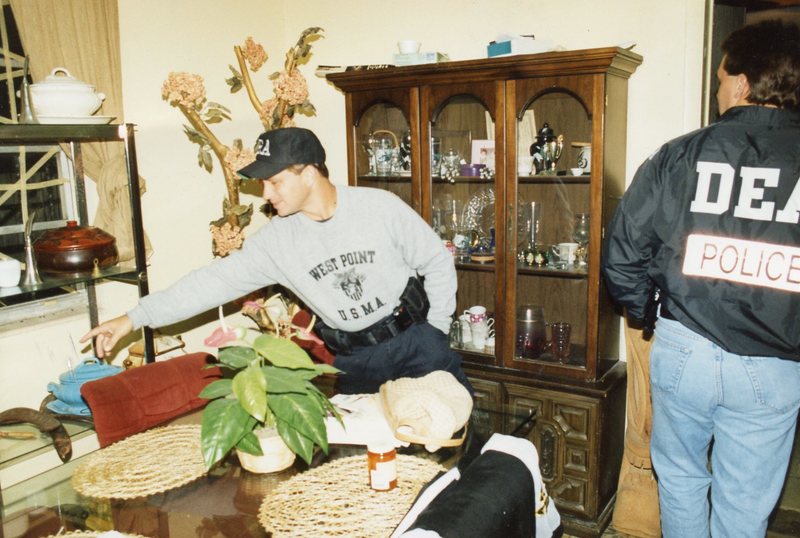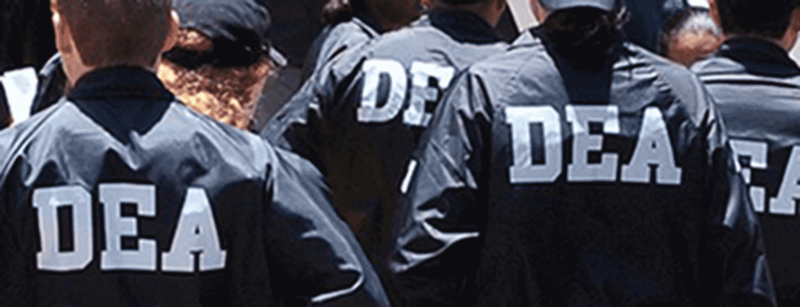Kevin Pedersen and Alex DeCubas were co-captains of their high school wrestling team who ended up on opposite sides of the War on Drugs. DeCubas became one of the nation’s most sought after drug kingpins, with connections to the Colombian drug cartels, and Pedersen became a decorated agent with the DEA, the agency tasked with arresting DeCubas.
It’s a helluva story, and ESPN is going all in on the tale with a sprawling new multi-platform project titled “Pin Kings”—the result of a year-long collaboration between Brett Forrest, a senior writer at ESPN The Magazine, and Jon Fish, a longtime ESPN producer.
Originally intended as a short segment on ESPN’s weekly TV program SC Featured, the project turned into a huge effort across television, audio, print, and digital and has become an example of how to execute a multi-platform story with lots of moving parts. The first episode of a 16-part podcast aired August 1, and its final episode, set for August 22, coincides with the broadcast of a one-hour documentary special on ESPN2. That will be followed a week later by a 5,000-word story in ESPN The Magazine. The whole thing is accompanied by a website featuring the full magazine story, interactive maps, graphics, and animations.
The project suggests a coming of age for multi-platform storytelling, which once involved media organizations plonking stories created for one platform onto another without consideration of how audience-consumption habits differ between TV, print, and digital environments. True multi-platform programming requires forethought and cooperation from Day One between departments that often do their own thing, a feat that can be difficult to achieve. Multi-platform executions aren’t new to ESPN, but the scale and scope of “Pin Kings” is its most comprehensive effort.

Alex DeCubas was co-captain of the Miami Palmetto Senior High School wrestling team. Photo credit: ESPN
For ESPN, the saga began with a tip from one of Forrest’s sources in Florida. Forrest called up Fish, and shortly thereafter they boarded planes for Miami where they met with Pedersen. It was the beginning of a journey that would take them from the Miami Palmetto Senior High School gymnasium to the heart of former Colombian cartel territory, from the personal and professional ups and downs of Pedersen and DeCubas to the history of the DEA.
Victor Vitarelli, senior coordinating producer in ESPN’s Features Unit, says the team realized they were onto something special when weekly editorial meetings continually ran over while Forrest and Fish gave updates on their reporting. “Very quickly we started to talk about, ‘Is there a good digital execution? What might we do in the magazine? What does TV want?” he says. Getting buy-in from the different departments happened naturally as people became hooked on the twists and turns of the story during a weekly cross-platform meeting dedicated to the project.
Each treatment of the story caters to the appropriate medium. The one-hour TV special takes a fairly standard approach with talking heads and reenactments. It’s also slicker, faster-paced, and more condensed than the audio version. “We’ve had some long days in the edit room where the running joke has just become, ‘Well, we’ll save that for the podcast,’ because you realize in the TV medium you really don’t have a lot of time. You need to hit story points that are interesting visually and then move on,” says Vitarelli. The footage—including scenes of drug drops from planes at sea and the remains of an impressive effort by DeCubas to build an efficient mode of drug transportation—enhance the story with visual imagery that listeners miss with the audio experience.
With the magazine presentation Forrest was “allowed to flex his muscles and tell a great story through his words,” while the digital component features interactive maps that enable the audience to visualize particular smuggling routes and their locations in relation to the coastline. The podcast, hosted by Forrest and Fish, is conversational and takes time to delve into details that the team glossed over in the TV special. It has a slower buildup of suspense and intrigue, and allows for insights and commentary about the experience of reporting. “We tried to conceal the ending of how this story resolves until this coming weekend, so that if you’re listening to the podcast you can listen to them all the way up,” says Vitarelli.
@Jonfish2 @ESPNPinKings it's taking all of my self control to not google alex decubas before I finish the pod.
— Tweet Incaviglia (@blackkdan) August 4, 2016
The ESPN approach won’t appeal to everyone, but the story of “Pin Kings” touches on universal themes that go beyond sports and beckon a broader audience. They decided to do a podcast because it would give them time to delve into all the material they had gathered. “There’s so many layers to that story that certainly podcasting was something that jumped up right away,” says Vitarelli. Unfamiliar with episodic podcasting, Vitarelli acknowledges that they were learning on the job. “From a storytelling standpoint it’s all new territory for us,” he says—a fact that wasn’t lost on some listeners.
#PinKings: The incredible story of two sports journalists learning to make a podcast.
— Blaine Perry (@DrScapino) August 6, 2016
ESPN’s willingness to embrace a new approach to storytelling reveals an experimental mindset that is important to achieving success with multi-platform projects. Jim Flink is a 20-year TV news veteran who now works with the Reynolds Journalism Institute (RJI) at the University of Missouri. In 2014 he headed a project that embedded journalists with digital skills into traditional newsrooms to increase multi-platform output. But he soon realized this method actually discouraged experimentation. “What we found when we embedded these small teams was that they became ‘those guys’ that do that content,” he says. “A lot what I work on now is trying to get people to really embrace the tools that they have in front of them that are intuitive.”
Not all experimentation is created equal, however, and Flink is often frustrated when he sees media organizations making basic mistakes. “For instance, really, really talented print journalists who are doing video, but they stand themselves in front of a blank wall and they’re just not very creative,” he says. “I think users and consumers demand more than that.”
Although attempts at multi-platform storytelling can end badly, smart executions are becoming more common. For its recent story about the private prison system, Mother Jones published Shane Bauer’s 35,000 word investigation in both the print magazine and on the web. The written story was accompanied by six short (less-than-five-minute) videos and an hour-long podcast produced by the Center for Investigative Reporting’s “Reveal” team. Parts of the videos are narrated by Bauer in his guard uniform and contain stills captured from a hidden camera, adding a visual element that couldn’t be replicated in text. The written story, which was the linchpin of the project, racked up more than one million page views in the first week and, between them, the videos have had more than half a million views to date, according to a spokesperson. The podcast aired on 330 radio stations around the country.
The time and resources required to create this kind of content can be prohibitive. Many media organizations have barely enough time to produce stories for a single platform, let alone think about additional content. There is also an argument to be made for focusing on telling a story in one format very well, rather than trying to be all things on all platforms.

Kevin Pedersen became a decorated agent with the DEA, the agency tasked with apprehending his former wrestling buddy from Palmetto Senior High. Photo credit: ESPN
Sometimes fans will take content creation into their own hands. When NPR’s “Serial” podcast went viral in 2014, the producers published a blog with interesting facets of the story that didn’t make it into the show and a host of maps, documents, and interactives. Nevertheless, 45,000 fans took to a Reddit page in an attempt to solve the mystery at the heart of the story. One fan, who is also a lawyer, uncovered evidence that helped the defense in its efforts to gain a new trial for the subject of the podcast. The downside of this kind of crowd-sourcing is that the journalist loses any ability to vet the content being posted, something Koenig has admitted made her uncomfortable.
At the same time, it’s not always relevant or conducive to a story to include multi-platform elements. A recent study conducted by RJI interviewed 53 millennials about how they engage with longform storytelling online. Their findings showed that while participants preferred stories that included visual elements, they wouldn’t click on them if they interfered with the flow of narrative. “I kind of wanted to read more of the article rather than clicking,” one participant said. “Usually that’s my style. I read the full entire article and click on links later just so I won’t get lost.”
That’s part of the reason the approach taken for “Pin Kings” works so well. “It’s not just, ‘Put this TV piece online or move the magazine and put it on dot com.’ It’s really about, how do you enhance the story in each platform so that you’re really making it a better experience for our viewers and our fans,” says Vitarelli. The ESPN team is already discussing future ideas that could replicate the scope of “Pin Kings,” including a story that unfolds week by week rather than a look back at an historical event. In their discussions, a trial-and-error approach remains important, according to Vitarelli. “We’re trying to figure out the best way to use all the platforms and we want to keep experimenting until we get it right.”
Shelley Hepworth , formerly a CJR Delacorte Fellow, is Technology Editor at The Conversation in Australia. Follow her on Twitter @shelleymiranda.

